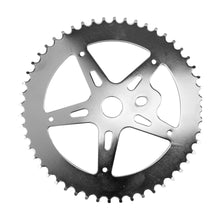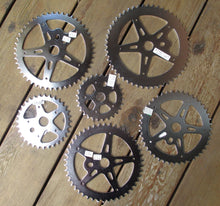The "CHAINRING 1pc SUNLiTe 52T 3/32 (for 7/8 geared Bikes ) sprocket is a single-piece chainring manufactured by the company SunLiTe. It has a tooth count of 52 and is designed to work with a 3/32 inch wide chain. This chainring is an excellent upgrade for cyclists seeking to increase the torque capabilities of their bike.
By installing this 52-tooth chainring, you will achieve a higher gear ratio when paired with a 16-tooth rear sprocket. This means that for each rotation of the pedals, the bike will cover a greater distance, making it well-suited for situations where more power is needed, such as climbing hills or carrying heavy loads.
Additionally, the 3/32 inch width of the chainring ensures compatibility with chains of the same specification. This is important for smooth and reliable operation of the drivetrain.
Overall, this chainring upgrade is a valuable modification for cyclists looking to enhance their bike's performance, particularly in scenarios demanding increased torque and power output. It can significantly improve the bike's capabilities in situations where extra strength is required, making it a popular choice for riders tackling challenging terrains or carrying heavy cargo.
By installing this 52-tooth chainring, you will achieve a higher gear ratio when paired with a 16-tooth rear sprocket. This means that for each rotation of the pedals, the bike will cover a greater distance, making it well-suited for situations where more power is needed, such as climbing hills or carrying heavy loads.
Additionally, the 3/32 inch width of the chainring ensures compatibility with chains of the same specification. This is important for smooth and reliable operation of the drivetrain.
Overall, this chainring upgrade is a valuable modification for cyclists looking to enhance their bike's performance, particularly in scenarios demanding increased torque and power output. It can significantly improve the bike's capabilities in situations where extra strength is required, making it a popular choice for riders tackling challenging terrains or carrying heavy cargo.
Using a larger chainring, like a 52-tooth (52t) chainring, can provide you with more torque on a bike compared to a smaller chainring.
Torque is the rotational force applied to an object, in this case, the force applied to the pedals to turn the crankset, which ultimately drives the bike's chain and propels it forward.
Here's how a larger chainring can give you more torque:
1. **Leverage**: The larger the chainring, the greater the leverage you have. Think of it like a wrench - a longer wrench allows you to apply more force. In this case, a larger chainring allows you to apply more force to the pedals.
2. **Gear Ratio**: A larger chainring, when paired with a smaller cog in the rear (like a smaller gear on your cassette), results in a higher gear ratio. This means that for each rotation of the pedals, the wheel makes a greater rotation. This increases the distance the bike moves for each pedal stroke, making it more efficient and giving you more speed. However, it also means you'll have to exert more force to turn the pedals.
3. **Mechanical Advantage**: A larger chainring offers a mechanical advantage. This means it allows you to convert more of your pedaling force into forward motion. It's similar to using a higher gear on a car, which allows you to use the engine's power more effectively for higher speeds.
It's important to note that while a larger chainring can provide more torque, it also requires more effort from the rider. This can be beneficial for experienced cyclists or those riding on flat terrain or downhill. However, on steep inclines or for riders who may not have as much leg strength, a smaller chainring may be more suitable as it requires less force to pedal.
Ultimately, the choice of chainring size depends on factors like your riding style, the terrain you'll be tackling, and your personal strength and preference. It's also worth noting that a larger chainring may also affect your cadence (pedal revolutions per minute), which can have implications on your overall cycling efficiency and endurance.
Torque is the rotational force applied to an object, in this case, the force applied to the pedals to turn the crankset, which ultimately drives the bike's chain and propels it forward.
Here's how a larger chainring can give you more torque:
1. **Leverage**: The larger the chainring, the greater the leverage you have. Think of it like a wrench - a longer wrench allows you to apply more force. In this case, a larger chainring allows you to apply more force to the pedals.
2. **Gear Ratio**: A larger chainring, when paired with a smaller cog in the rear (like a smaller gear on your cassette), results in a higher gear ratio. This means that for each rotation of the pedals, the wheel makes a greater rotation. This increases the distance the bike moves for each pedal stroke, making it more efficient and giving you more speed. However, it also means you'll have to exert more force to turn the pedals.
3. **Mechanical Advantage**: A larger chainring offers a mechanical advantage. This means it allows you to convert more of your pedaling force into forward motion. It's similar to using a higher gear on a car, which allows you to use the engine's power more effectively for higher speeds.
It's important to note that while a larger chainring can provide more torque, it also requires more effort from the rider. This can be beneficial for experienced cyclists or those riding on flat terrain or downhill. However, on steep inclines or for riders who may not have as much leg strength, a smaller chainring may be more suitable as it requires less force to pedal.
Ultimately, the choice of chainring size depends on factors like your riding style, the terrain you'll be tackling, and your personal strength and preference. It's also worth noting that a larger chainring may also affect your cadence (pedal revolutions per minute), which can have implications on your overall cycling efficiency and endurance.

# A Guide to Bicycle Chainrings: Choosing the Right Replacement
Bicycle chainrings play a crucial role in the efficiency and performance of your bike. They are the toothed rings that attach to your crankset and engage with the bicycle chain. When it's time to replace a worn-out or damaged chainring, it's important to understand what factors to consider. In this guide, we'll cover the key aspects you need to keep in mind when buying a replacement.
1. Understanding Chainring Basics
a. Chainring Size
Chainrings are measured by the number of teeth they have. For example, a chainring with 52 teeth is larger than one with 42 teeth. The size affects the gearing ratio, influencing how easy or hard it is to pedal.
b. BCD (Bolt Circle Diameter)
Bicycle chainrings play a crucial role in the efficiency and performance of your bike. They are the toothed rings that attach to your crankset and engage with the bicycle chain. When it's time to replace a worn-out or damaged chainring, it's important to understand what factors to consider. In this guide, we'll cover the key aspects you need to keep in mind when buying a replacement.
1. Understanding Chainring Basics
a. Chainring Size
Chainrings are measured by the number of teeth they have. For example, a chainring with 52 teeth is larger than one with 42 teeth. The size affects the gearing ratio, influencing how easy or hard it is to pedal.
b. BCD (Bolt Circle Diameter)

This is a crucial measurement to get right. The BCD is the diameter of the circle that passes through the centers of the chainring bolts. It's important because it determines whether a chainring will fit on your crankset. Common BCD sizes include 110mm, 130mm, and 144mm, but there are others as well.

2. What to Measure
a. Number of Bolts
Check how many bolts secure your chainring to the crankset. This is typically either 4 or 5 bolts. It's important to get a replacement with the same number of bolts to ensure a secure fit.
b. BCD Measurement
To measure BCD, you'll need a ruler or caliper. Place one arm on the center of a bolt hole and measure to the center of the hole directly opposite. If you're not confident in your measurement, it's best to consult a professional or use specialized tools.

|
 |
 |
3. Things to Ensure Match
a. BCD Compatibility
Ensure that the BCD of your new chainring matches the BCD of your crankset. A chainring with the wrong BCD will not fit properly and can lead to poor shifting and potential damage.
b. Teeth Count
If you're happy with your current gear ratios, it's a good idea to stick with a similar number of teeth on your replacement chainring. However, if you want to adjust your gear ratios, you can experiment with different tooth counts.

|
 |
 |
a. Ignoring Wear and Tear
Don't delay replacing a worn chainring. A worn chainring can lead to poor shifting, chain slippage, and accelerated wear on other drivetrain components.
b. Mixing Incompatible Components
Avoid trying to force a chainring with the wrong BCD onto your crankset. This can lead to damage to both the chainring and the crankset.
Choosing the right replacement chainring involves understanding key measurements like BCD, teeth count, and bolt number. It's crucial to ensure compatibility with your existing components to maintain smooth and efficient operation. Remember, if you're uncertain, seeking advice from a professional at your local bike shop is always a wise move. With the right replacement, your bike will continue to perform at its best.






